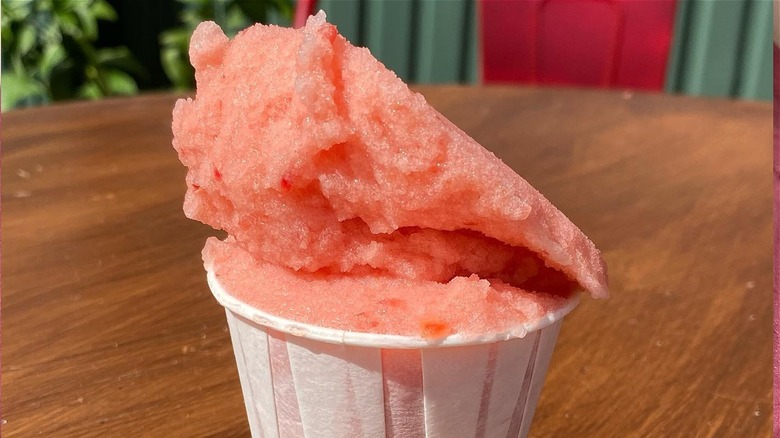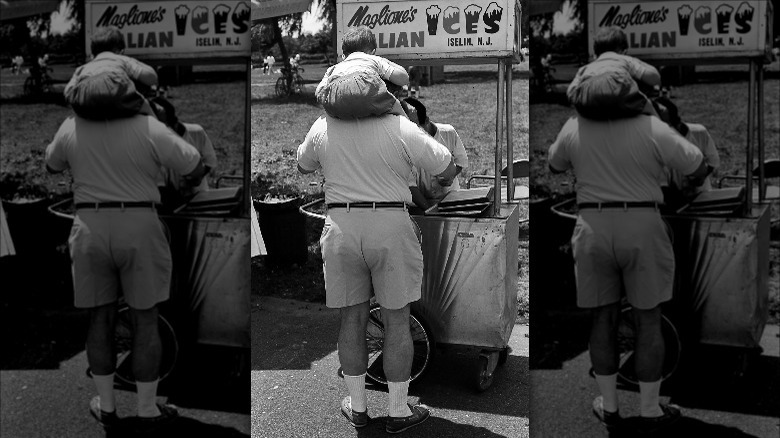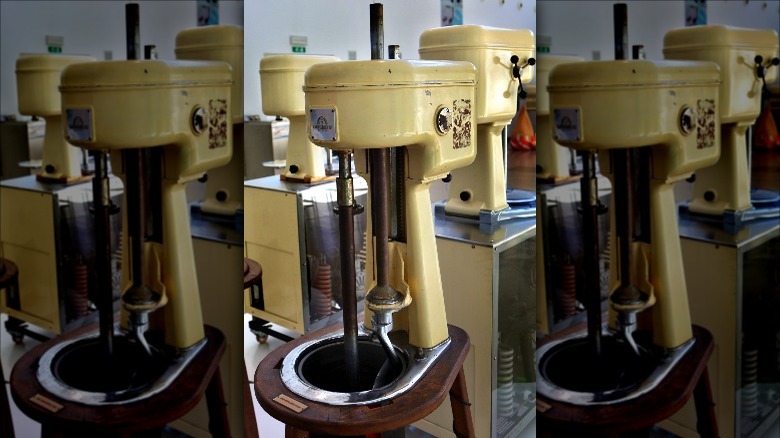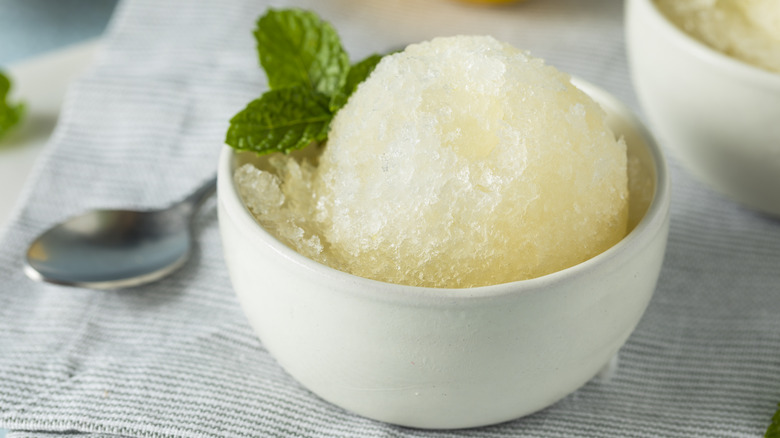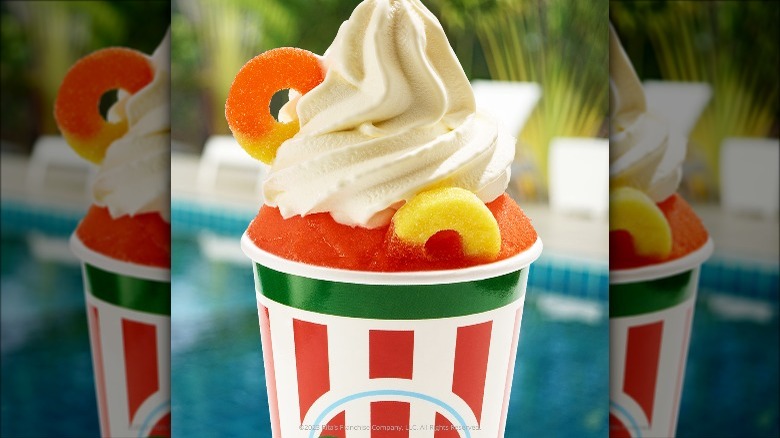What Italian Ice Is And Isn't
While frozen desserts are available year-round, once the warmer weather hits, everyone's thoughts seem to turn to these treats as shaved ice, snow cones, and frozen custard stands start popping up to supplement the year-round offerings. Italian ice is one such seasonal treat, so much so that one major chain, Rita's Italian Ice, gets a months-long jump on summer fun by giving away free scoops on the vernal equinox. Their product is so popular that people line up to get it even if the arrival of spring is heralded with a snowstorm.
What makes Italian ice a frozen treat worth braving in such freezing weather? Before we celebrate its delights, let's start by differentiating it from similar frozen concoctions. Unlike ice cream, gelato, or frozen custard, Italian ice contains no dairy or eggs. In fact, nearly all the Italian ice flavors carried by Rita's are vegan. Snow cones and shaved ice may also be sweet, fruity, and dairy-free, but Italian ice is much smoother, and the flavor is evenly dispersed throughout the product due to being added before freezing. The products most similar in flavor and texture to Italian ice are sorbet and granita. In both cases, Italian ice is again the smoother product due to having air whipped into it while it's being frozen.
The history of Italian ice
Granita and Italian ice, as we know them today, may have some slight differences, although there may be some ambiguity here, as certain sources consider them to be the same. Even acknowledging the distinction between the two, however, the former could at least be considered the direct progenitor of the latter. Both desserts share an ancient pedigree as it's thought that a proto-granita was first created by 10th-century Arab immigrants who mixed the snow from atop Sicily's Mount Etna with citrus fruits and sugar. Centuries later, Italian immigrants, in their turn, brought their recipes for these icy Sicilian desserts to the United States.
Vice claims that New Jersey-based DiCosmo's Italian Ice may be the original purveyor of these treats in the U.S., as the company was established in 1915. However, Repicci's Real Italian Ice in Philadelphia says it started making the stuff as early as 1911. Rosati Ice, another Philadelphia-area company, proclaims on its cups that it dates back to 1912 and is another candidate for the title of America's first Italian ice company. Supermarket favorite Luigi's, on the other hand, is a relative newcomer as it wasn't established until 1978. However, its paper cups with their colorful contents have appeared in grocery frozen food aisles since 1989.
How Italian ice is made
The process of making Italian ice commercially involves combining all of the ingredients and then freezing them in such a way that they are whipped as they chill. This requires a special appliance called a batch freezer; of course, these are not cheap. One capable of producing just a few quarts can run several thousand dollars, while freezers capable of producing a dozen or so batches run well into five figures.
So can you make a reasonable dupe of Italian ice at home without such a fancy freezer? Not really. A DIY Italian ice recipe typically requires you to freeze the sweetened, fruit-flavored liquid base, stirring it occasionally. Once it freezes solid, you'll then scrape it with a fork. All of the stirring and scraping will prevent it from forming a solid block of ice, but without the additional air that you get from constantly agitating the mixture as it freezes, the ice crystals will be larger. The texture won't be nearly as smooth and creamy as the Italian ice you can buy from a stand or even the stuff you'd get at a supermarket.
Typical ingredients of Italian ice
If you opt to make Italian ice at home, you can do so using nothing more than fruit juice (fresh-squeezed lemon juice is a popular option), sugar, and water. While no Mount Etna snow is required, you can fancy things up by adding citrus zest, mint leaves, or other flavorings if you wish. It is also possible to make non-fruit flavors of Italian ice, such as chocolate or coffee, as well.
Commercially produced Italian ice, however, offers several other options for making it. Some manufacturers may still opt for fresh fruits, others may use flavoring extracts, and others will use a pre-mixed base. This last option offers a wide variety of Italian Ice flavors, as such bases can be purchased in varieties including blue raspberry, cotton candy, root beer, and sour fruit that might be difficult to duplicate using only fresh ingredients. Some commercial recipes also call for additional ingredients, including non-dairy creamer or citric acid, as well as stabilizers meant to maintain the Italian ice at its optimal texture.
Italian ice variants
While Italian ice can certainly stand on its own, it also plays nicely with other ingredients. Rita's has an entire line of products that start with Italian ice, then give it a unique spin. One of these may literally involve spinning it in a blender to make a slushie-type drink. The others all involve the addition of frozen custard: the Misto shake is Italian ice plus custard. The Blendini is a sundae version of the same, and the Gelati (which is not to be confused with gelato) is made by layering Italian ice and custard.
Something that family-friendly Rita's does not sell is boozed-up Italian ices, but one publication, PA Eats, endorses spiking this Pennsylvania-based chain's product with vodka (they would, of course, prefer that you use one from a Keystone state distillery). Another, albeit more expensive, option would be ordering alcohol-infused Italian ice from a company called Carmelo's. These are available in flavors, including pina colada, strawberry margarita, and strawberry daiquiri, and are currently priced between $64.10 and $68.75 per 2.5-gallon bucket. It appears, though, that these alcoholic Italian ices may not be available for purchase by retail consumers as they seem to be geared more toward a wholesale market.
Who sells Italian ice?
If you live in either New York City or Philadelphia or in any of their surrounding suburbs (including those that are technically part of New Jersey), you're pretty much at ground zero for Italian ice in America. Some hot spots for this cool treat in NYC include Benfaremo (aka The Lemon Ice King of Corona) in Queens, New York Icery in Brooklyn, and Pasticceria Rocco in Greenwich Village. In Philadelphia, where Italian ice is known as water ice, your options include Famous Italian Ices, Fred's Water Ice (Fred's sells the stuff by the gallon and the cup), and Dre's Homemade Water Ice and Ice Cream.
Italian ice isn't strictly a regional specialty. However, in other places, it might be a less popular option than the frozen custard beloved by Midwesterners or the famous Baltimore treat known as snowballs. Still, there are a few nationwide chains serving the stuff, including Uncle Louie G's, with a six-state empire including Texas, Tennessee, South Carolina, and Florida, as well as New York and Pennsylvania; and Rita's, with a coast-to-coast presence in 29 states and the District of Columbia. If you're in one of the other 21 states, you can probably still buy Italian ice in the grocery store from brands such as Lindy's, Wyler's, and Luigi's.
